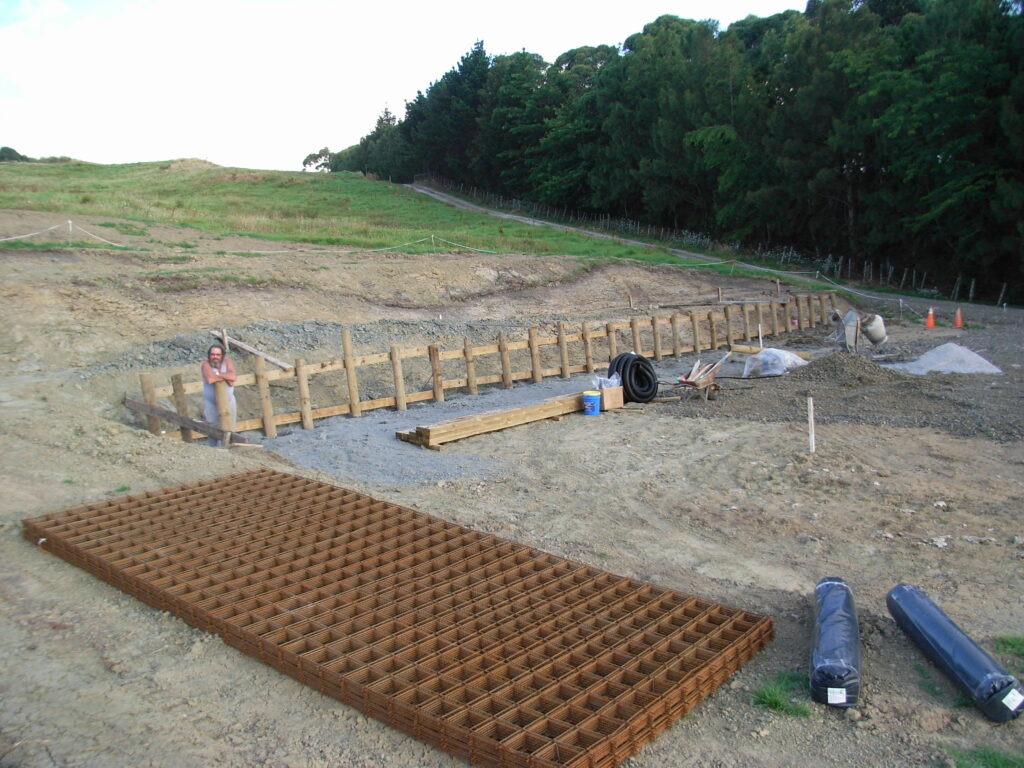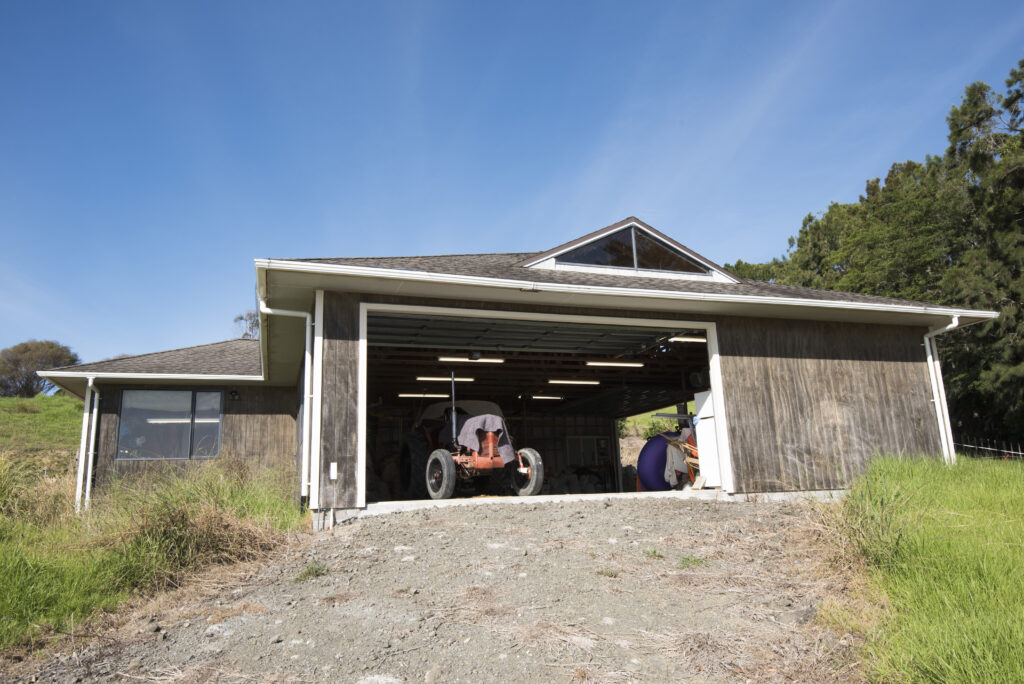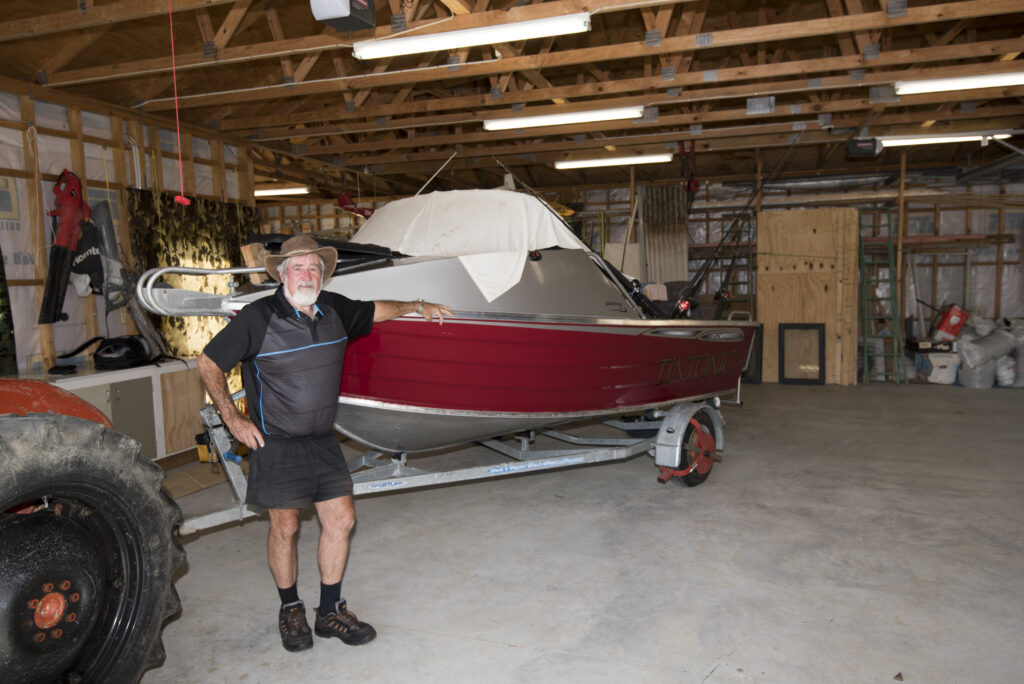Building a new shed was a case of thinking on a grand scale
By Rod Kane
Photographs: Jude Woodside




Back in the carefree/careless days we took a drive up to the Hokianga harbour, mainly for a fish and chip meal at the legendary Omapere pub, and promptly fell in love with the place. It’s New Zealand 50 years ago: clean, uncluttered with houses and people and just plain beautiful on any given day.
The harbour simply sparkles on a sunny day and the dunes on the north head are nothing short of spectacular. The views coming over the ridge from Waimamaku and the Waipoua forest are breath-taking. We still stop and try to take it all in.
Everything moves at a leisurely pace up at the “Hoki”. It is still a hidden gem, but not for long I feel. We have a few celebs up there now and there are more and more serious homes going up, but it still has that laid back feel to it. Opo the dolphin is the only thing that has happened to the area and that was 60 years ago. The shop was replaced when the old one burnt down – the new one is identical to the old one. We have a new Internet centre and café and the ice creams/fish and chips are still rock solid and fabulously delicimo after all these years. The people are really friendly.
We decided to have a look for a suitable section and very quickly settled on a grassy block right on the water just out of Opononi.
It wasn’t long before we built a shed down by the water, mainly for the obligatory boat, dinghies, tractor and various other cheap but fun toys. It also served as a place to holiday and camp in; rough but comfy with generated power, kero lights, long drop, etc.
As time went by the boats/machinery got bigger and more numerous. It quickly became evident that just to open the back door on arrival to get the kids to the long drop took about an hour of work, starting old tractors and moving boats. By this time the need for the long drop had long since passed and we were more into change of clothes mode.
Everything we put into the place had to come from the discretionary spend, like most holiday properties, so everything was cast offs from home or second hand, nothing ritzy.
Then came the day I bought a new boat, nothing big or flash but a seriously suitable fishing runabout and to me it was the Royal Yacht Britannia. I called it Tintonic, very much after the famous film of the day and I hoped I wouldn’t steer it to a similar fate, but the play on words appealed.
“All the old gear needed its own shed and if I was going to build a shed then it may as well be something of decent proportions.”



Priorities
Not long after that we decided that the boat and all the old gear needed its own shed and if I was going to build a shed then it may as well be something of decent proportions so I wouldn’t be tempted to add to it. I decided on a size and floor plan then added a metre all round.
There is something called “economies of scale” which is really self explanatory and it was a good excuse to get a bigger shed for not a lot more money. I was ecstatic when the architect explained the principle to my dear but unconvinced wife. There’s an economy of ganging-up numbers too. Well, it worked for me at the time but I doubt I would get away with that line a second time.
At that stage of our lives we were fully intent on looking at moving up to the Hokianga to live full time and building a bed and breakfast/farm-stay accommodation on the property, so any shed had to complement the main house design rather than clash with it. Since then we have gone off humans and cleaning toilets so the farmstay residence was never built.
The shed had to have extra stud height to take the boat with the rods in their holders and the canopy up, plus it had to have big doors front and back so that the tractor and boat could be driven in one end, parked up, and then driven straight out the other. It’s called priorities and reversing was a no-no.
I wanted a truss roof with no ceilings as a feature to look at as well as provide depth and dormer windows to light it all up. Being so close to the salt water, the right building materials had to be used to prevent corrosion and to withstand the famous Hokianga sou-westerlies which blast in straight off the harbour in spectacular fashion like an angry mobile salt mine.
Last but not least it needed a workshop annex integrated into the design so that I could maintain everything as it needed repair and maintenance. Boats, tractors and the like need a lot, especially old ones.


“I think he might have straightened out a few of those switchback corners in the Waipoua forest.”
Effective design
As luck would have it there was an excellent architect up at the Hokianga with town planning experience and he was quite happy to indulge my eccentricities. He quickly came up with a design that was both simple, effective and workable. It was also rather attractive and fitted in with the main residence plans which he also produced at the same time.
What we ended up with was a shed roughly 18m x 10m with a 3m stud, 12mm shadow-clad ply on the walls and asphalt shingles overlaying 15mm ply on the roof. All fixtures were stainless steel and they needed to be. The windows were all aluminium framed and two big 5.4m, extra-strength sectional doors finished it off.
It was important to us to engage as much local labour and material as possible and, to a very large extent, we managed to do that. However, some of the local prices at the time couldn’t match the Auckland prices and we had to import the roof, walls and trusses from home.
Resource consent and a building permit were obtained with remarkably little fuss from the Far North District Council – the architect knew all the rules and it all went commendably well. I would hate to have to repeat this process in Auckland. Enough said.
It was a sloping site so quite a lot of material was shifted to take the large floor and its buffer areas. We engaged a brilliant local contractor for this and once finished my bro’ very kindly offered to come up and take on the laying of the floor and the retaining walls with my help.
It was a stinking hot summer when we did all this and I will never forget it. Builder’s cracks looked more like hot cross buns but we got all the foundations dug, the steel in place and the floor laid out.

Big structure
Local contractors did the block work and poured the concrete floor after it was all inspected by the council. Once it was all laid it became very apparent that it was a pretty big structure and I did wonder if my imagination had, once more, overshot the mark a tad.
We engaged a local builder with a great reputation for competence and reliability and then the truck turned up from Auckland with all the building materials.
I have never seen anything like it in my life and I think they are still talking about it down at Opononi. A huge truck and trailer delivered right on time and in one massive load 10-metre-long trusses, the ply roof, asphalt shingles, all framing, windows, cladding, building paper and fittings. He did the return trip in a day. I was exhausted just thinking about it and I think he might have straightened out a few of those switchback corners in the Waipoua forest, just quietly.
The builder set to with the sort of enthusiasm that only other people have and after a typically laconic comment – “It’s a big shed Rod” – he got stuck in and soon had the framing up. I arrived to help with the plywood roof base and laying out the building paper ready for the roof layers.


Roof challenge
The shingle roof was something I was going to do myself but it was huge and I could see myself stapling them on over a period of weeks and then stapling them back on again when they all blew off. There was no future in this so I hired a team of experienced young bucks to get them on in one day. I awoke at 5am to the sound of compressors and agile feet dancing over the roof leaping from ridge to ridge. I was very pleased they hadn’t seen me the day before on my hands and knees like a terrified pixie with a stapler in one hand and rosary beads in the other, even though I am absolutely not religious.
By 2pm it was done, the guys paid and on their way home and the new roof looked magnificent. It had done a job on my wallet but it did look the part.
The builder sorted out the final bits and pieces and left with a smile on his face after the inspector had given the new shed his approval.
The builder had done a magnificent job, real old-fashioned craftsmanship and you can still just see the light pencil lines he drew on the ply before carefully placing the stainless nails. Likewise the other contractors were great. I learned many years ago to pay on time or before time if you really want to get a healthy relationship going with your subbies. Nobody had to wait: if it was a one-day job, they got paid that same day. It made no difference to me as it had to be paid anyway, but it did make a difference to them. I was a contractor myself for many years and I soon learnt which clients to avoid.
This project cost about $100,000 eight years ago which I considered very reasonable at the time considering the size of it and the materials used.
It’s a quality unit and should stand the test of time. It will give others pleasure way beyond me.


The result
For those of you who have not had the pleasure of building your own shed, I would recommend this, if for no other reason than brain therapy. Nothing, and I mean (almost) nothing, beats standing in your shed and looking over the wide empty spaces and up into the trusses. You can fill it with shelves and benches and boats and gear and never use any of it and for some strange reason it makes you feel useful. You can’t buy that. When you feel you are getting hounded for not pulling your weight, you just go up to your shed. How good is that?
This shed is less than 100m from the water and that is about two minutes at top speed to the best fishing spots. We have security lights and alarms, of course, plus some wonderful ever-vigilant neighbours and we spend a sizeable amount of time up there ourselves. So far so good but I guess part of the trick is to not have anything in a shed or bach of any real value, then you don’t fret, and ours is no exception.
We give the shed a coat of linseed oil, turps and kero once every couple of years and that takes about 3 hours and 40 litres with a 5-litre garden sprayer. Easy as. Other than that, it is very low maintenance.
A decent shed is a thing of beauty and a joy forever. I would have married it but that sort of thing is against the law and, of course, familiarity breeds contempt and I didn’t want that with my shed.
“Nothing, and I mean (almost) nothing, beats standing in your shed and looking over the wide empty spaces.”

Work space
There is always something to repair, build or modify at a holiday property and the workshop annex is a very pleasant sort of place to do all this. Just as well.
None of my tools are of commercial quality, just home handyman stuff, then it’s affordable and you can have one of everything, or two where you can get away with it. We like buying tools, don’t we?
In addition to a good range of woodworking and mechanic’s hand tools, I have things like a drop saw, bandsaw, tablesaw, chainsaw, skill saw, jigsaw, etc. There is a small arc welder plus various drills, multi-tools, a table drill, grinders, heat guns, planers and that sort of thing. Everything gets used.
I have a couple of big, solid work benches with vices and overhead lights. It’s all very handy for all sorts of repairs and builds, everything from fixing broken furniture and making wooden beach trailers to welding up grills for the incinerator and stripping down outboards.
I also have a stock of various building materials in racks for tarting up the buildings as we can afford the time and resources to do it. It’s a long way to go for material supplies and if you have to go to town specifically for it, the job won’t get done. That could be a good tip for some guys.
One of the most-used tools is a vac sealer, very cheap at about $70. Any fresh fish we (I say “we” for the benefit of my mates but it’s a lie) catch and want to take home, gets filleted and vac sealed in meal-size portions. In the freezer it lasts for many months and the texture/taste is like fresh fish when thawed.
Excess bait from a trip gets salted down over 24 hours, placed in a vac bag with half a cup of fish oil and then vac sealed. It doesn’t have to be refrigerated and can last for months like that, ready for use in the boat. We find it makes better bait than fresh fish. It’s also excellent burley, leaving a very oily scent trail.




